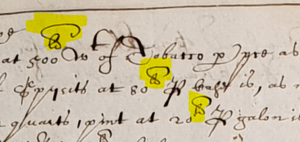Transcription Resources
From MarineLives
Revision as of 10:16, December 15, 2021 by CharlieWilson (Talk | contribs) (Created page with "== Palaeography is fun! == Included on this page are resources that volunteers have found to be useful when transcribing 17th century documents. Some are short courses, other...")
Palaeography is fun!
Included on this page are resources that volunteers have found to be useful when transcribing 17th century documents. Some are short courses, others books full of samples to refer to.
Not all will be directly relevant to the materials here, but all are good practice.
Also on this page we will be including snips from the documents themselves, particularly for those "aha!" moments when you realise what a letter, or word is, and it shines light on other parts of the document. Please feel free to add these in the section below.
General palaeography tutorials
- National Archives - an extensive tutorial, spanning handwriting examples from 1500-1800. The further practice section has some unusual documents arranged by date.
- Borthwick Palaeography Guides- The Borthwick has recently republished Reading the Past: Sixteenth and Seventeenth Century English Handwriting by P.M. Hoskin, S.L. Slinn and C.C. Webb, and made a pdf of the book freely downloadable. Lots of samples and associated transcriptions as well as example letter forms and abbreviations.
- English Handwriting Online - a free online short course covering 1500-1700, produced as part of the COPIA project.
- The Beinecke Library has a guide specific to Secretary hand, the dominant formal/professional handwriting in English between the 15th and 17th centuries.
Books
For some time away from a screen, I recommend Hilary Marshall Palaeography for Family and Local Historians (2004) - a very helpful book with plenty of samples.
Samples
